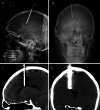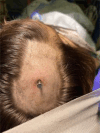Improbable discovery of an incidental high-grade AVM: illustrative case
- PMID: 40294522
- PMCID: PMC12036358
- DOI: 10.3171/CASE24850
Improbable discovery of an incidental high-grade AVM: illustrative case
Abstract
Background: The authors discuss the first reported case of a large, high-grade arteriovenous malformation (AVM) in the dominant hemisphere, discovered incidentally after a penetrating nail gun injury.
Observations: The patient underwent surgical removal of a nail lodged in the right frontal lobe. A contralateral AVM was diagnosed on his perioperative imaging and was evaluated further with diagnostic cerebral angiography. Because of the location of the AVM within the dominant fronto-opercular region, the patient underwent a super-selective Wada test to evaluate for the risk of expressive language deficit prior to undergoing a successful resection of the AVM. He had an excellent recovery from both surgeries without any neurological deficits.
Lessons: This case illustrates the importance of continued suspicion for incidental findings when reviewing imaging, despite the presence of a known and obvious pathology. The observations add nuance to the standard considerations for surgical intervention for penetrating nail gun injuries, and the workup for incidentally found vascular lesions is reviewed. https://thejns.org/doi/10.3171/CASE24850.
Keywords: cerebral arteriovenous malformation; incidental finding; nail gun injury; penetrating traumatic brain injury.
Figures





Similar articles
-
Self-inflicted bilateral penetrating brain injury with a nail gun in an African American male: illustrative case.J Neurosurg Case Lessons. 2025 Feb 10;9(6):CASE24520. doi: 10.3171/CASE24520. Print 2025 Feb 10. J Neurosurg Case Lessons. 2025. PMID: 39928930 Free PMC article.
-
An uncommon cause of penetrating brain injury: two cases of nail gun injuries. Illustrative cases.J Neurosurg Case Lessons. 2024 Dec 16;8(25):CASE24522. doi: 10.3171/CASE24522. Print 2024 Dec 16. J Neurosurg Case Lessons. 2024. PMID: 39680880 Free PMC article.
-
Penetrating intracranial nail-gun injury to the middle cerebral artery: A successful primary repair.Surg Neurol Int. 2015 Sep 28;6:152. doi: 10.4103/2152-7806.166168. eCollection 2015. Surg Neurol Int. 2015. PMID: 26500798 Free PMC article.
-
Nail gun injuries to the head with minimal neurological consequences: a case series.J Med Case Rep. 2016 Mar 16;10:58. doi: 10.1186/s13256-016-0839-1. J Med Case Rep. 2016. PMID: 27080512 Free PMC article. Review.
-
Management of Penetrating Brain Injury Caused by a Nail Gun: Three Case Reports and Literature Review.World Neurosurg. 2018 Apr;112:143-147. doi: 10.1016/j.wneu.2018.01.127. Epub 2018 Jan 31. World Neurosurg. 2018. PMID: 29410036 Review.
References
-
- Can A Gross BA Du R.. The natural history of cerebral arteriovenous malformations. Handb Clin Neurol. 2017;143:15-24. - PubMed
-
- Bican O, Cho C, Lee L.Positive pharmacologic provocative testing with methohexital during cerebral arteriovenous malformation embolization. Clin Imaging. 2018;51:155-159. - PubMed
-
- Tawk RG Tummala RP Memon MZ Siddiqui AH Hopkins LN Levy EI.. Utility of pharmacologic provocative neurological testing before embolization of occipital lobe arteriovenous malformations. World Neurosurg. 2011;76(3-4):276-281. - PubMed
LinkOut - more resources
Full Text Sources

